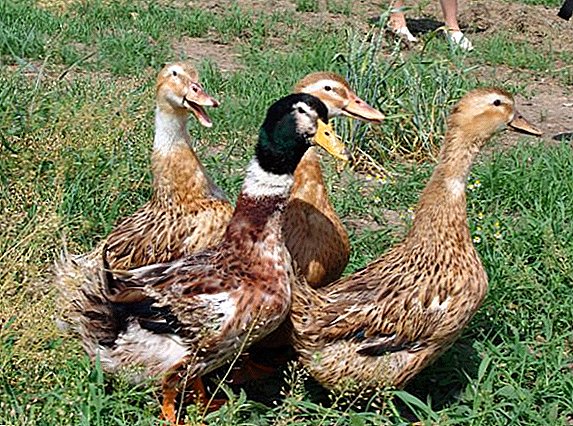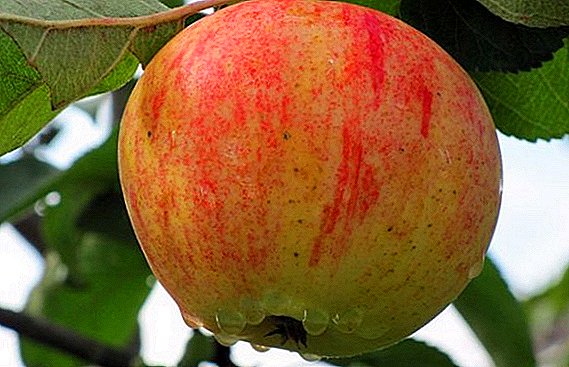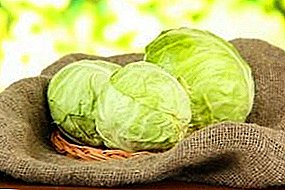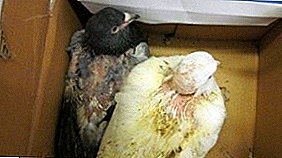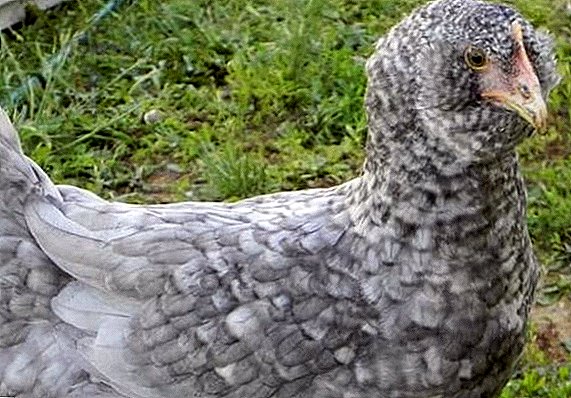 Chicken is the most popular poultry that man has been breeding for several millennia. It may seem that we know literally everything about her, and there is nothing more to surprise us with the bird. But this statement does not apply to the Grunleger breed, which does not carry simple eggs, but colored ones.
Chicken is the most popular poultry that man has been breeding for several millennia. It may seem that we know literally everything about her, and there is nothing more to surprise us with the bird. But this statement does not apply to the Grunleger breed, which does not carry simple eggs, but colored ones.
Breed description
Homeland breed Grunleger is Austria. In the same alpine country, this cross was most prevalent. After its appearance at various bird and agricultural exhibitions, the breed began to enjoy a certain success in Europe, and only then appeared on the markets of Russia.
Did you know? In Russia breed Grunleger called "Easter chicken" because of the variety of colors of eggs.Grunleger refers to the egg breed of chickens. Basically, this cross is derived by crossing roosters of the Araucan breed and local hybrids. In the first generation, laying hens give eggs of one of the colors: blue, green, pink, brown. The next generations are separated by color, and can bring eggs of all the shades listed.

External characteristics
The breed has not only a unique quality to bring colorful eggs, but it also has a very beautiful color of various colors and combinations. Another characteristic feature is a peculiar mane that surrounds the bird's head on all sides.
The best representatives of the egg direction are such breeds of chickens: Leggorn, Iza Brown, Loman Brown, High-Line, Russian White, Ukrainian Ushanka, Orlovskaya, Pavlovskaya, Minorka.
Females
Characteristic features of chickens:
- body size - medium;
- weight - 1.8-2.5 kg;
- egg production - about 300 pcs. in year.
They are distinguished by a diverse color from blue to black in completely different combinations. The chickens present a mane with a peculiar beard. Paws of the hens are medium, without plumage.
A small head on a small neck is crowned with an equally small crest. Eye color depends on the color of the bird.
Males
 Roosters have an average body size, weight from 1.8 to 2.8 kg. They do not have a pronounced peculiarity of hens - manes and beards, but they have a much larger crest.
Roosters have an average body size, weight from 1.8 to 2.8 kg. They do not have a pronounced peculiarity of hens - manes and beards, but they have a much larger crest.
Important! Grunleghery, as well as other breeds of egg hens, need a large amount of calcium - the main building material of the eggshell. It is for this reason that feathered, especially milk products, chalk and eggshells are extremely necessary in the diet for birds and especially for layers.
Pros and cons of breed
Among the advantages characteristic of this breed of chickens are:
- it is a beautiful bird that is suitable for decorative breeding;
- the presence of rare eggs;
- high performance (like egg-breed chickens);
- Birds are absolutely undemanding in care and feeding.
For greater objectivity, it is worth mentioning also some shortcomings:
- the breed carries heavily cold;
- layers do not have maternal instinct.
Puberty and the onset of egg production
Lay eggs of chickens begin about six months. Despite the fact that the breed does not differ early maturation, Quicksaw are very productive - 290-320 eggs annually, weighing about 60 g each. 
Breed performance
An adult hen can produce from 280 to 320 eggs per year. As already mentioned, the breed is focused on the production of eggs, so that a large amount of meat from Austrian birds can not wait. A chicken carcass, after cutting and removing the viscera, will weigh on average about 2 kg. The weight of males is 200-300 grams more.
Find out what vitamins are necessary for laying hens to increase egg production.
Maintenance and care
The breed does not have any particular content requirements. Grunleglers do not like cold, they do not tolerate cold and can get sick if the room temperature drops below + 12 ... -15 degrees. This must be remembered and initially taken into account when buying chickens for breeding. The rest of the birds have no special needs.
Did you know? At araukan (descendant of modernrünlegger the pigment biliverdin was present in the body, thanks to which the eggs of the bird received a blue color. This quality was inherited by the Grunlegger cross, whose eggs already had a wider color spectrum.
Housing equipment
Poor cold tolerance is perhaps the most significant deficiency in the breed. If you decide to start breeding Austrians, first of all warm the walls and floor of the chicken coop. Create comfortable conditions for wintering: purchase additional heating devices and special lamps to extend the daylight, eliminate all drafts.  Lighting in the hen house Equip the perches, at the rate of 20 cm per person per bird. The distance between adjacent perches should be at least 35 cm, the distance to the wall - 50 cm.
Lighting in the hen house Equip the perches, at the rate of 20 cm per person per bird. The distance between adjacent perches should be at least 35 cm, the distance to the wall - 50 cm.
Familiarize yourself with the features of keeping chickens in winter.
Diet
A few rules that should guide the preparation of the diet for these unusual birds:
- It is advisable to feed the bird twice a day (in the morning and in the evening) in the warm season (chickens get a lot of nutrients during walking), and three times a day, when walking time is limited.
- It is necessary to cook moist food every day, as its birds absorb best of all. Such mixers are made from various grains, skim milk, vegetables and their decoctions, with vitamin and mineral supplements (special attention should be paid to calcium supplements).
- Before puberty, high-protein combination feeds are used.
- In the cold season, you should increase the diet by 1/10 of the summer norm.
- Cottage cheese, yogurt, chalk, chopped eggshell and fish oil will perfectly complement the diet and have a beneficial effect on the immune system.
- Do not forget about the daily replacement of water (wash the pots well, but without the use of chemical detergents).

Temperature and light conditions
The temperature regime plays a very important role in the content of the cross. As mentioned above, the Austrians are extremely bad for cold. For this reason, in winter it is necessary to regularly change the litter so that it is constantly dry. A peat pillow is well-suited for bedding for grunlegers.
As you know, the chicken rushes only in the light (both natural and artificial). Therefore, if you expect good productivity from your hens, provide them with a sufficient day length - 13.5-15.5 hours.
Important! The color of the Grünlegger eggs is not affected by the color of the chicken, as previously thought, but by a number of other factors: diet, health status, season of the year, and age.
Egg Incubation
In the Grunlegerov maternal instincts are extremely weak. Even if the hen will sit down to hatch eggs, she is unlikely to be able to finish the job. So it is more expedient to use an incubator to get chickens.
Incubation of chickens of this breed is an extremely interesting and entertaining lottery. The fact is that it is impossible to guess what color the chicks will be born and the eggs of what color will be carried in the future.
Learn how to raise chicks with an incubator.
During home incubation, hybrids in the second generation often lose their inherited traits. The reason for this are the features of selection and genetic heredity.  In order for the breed not to degenerate, the poultry farmers came up with a simple solution - using the purebred rooster Araukan for his father's functions.
In order for the breed not to degenerate, the poultry farmers came up with a simple solution - using the purebred rooster Araukan for his father's functions.
The general rules for the selection of incubation material, its insertion into the incubator, the incubation stages are exactly the same as those of other breeds.
Care for the young
After the chicks hatch (on the 22nd day), for their normal development and growth you should follow the simple recommendations:
- When the chicks are dry, they should be transplanted into a suitable box, and transferred to a room heated beforehand to a temperature of + 35 ° C.
- Until the chickens reach ten days of age, they are fed with a mixture of greens, crushed corn and eggs.
- Fermented milk products, yeast, boiled vegetables, vitamin and mineral supplements and fish oil are used as top dressing. Starting from 1 month, finely ground high protein feed, chalk, and egg shells are introduced into the diet.
- Until the chickens reach the age of 15 days, they are watered with warm fresh water and glucose syrup with the addition of vitamin C.
- From the first days of life it is necessary to maintain the high temperature of the room, cleanliness and dryness in the place where the chickens are kept. Gradually, the air temperature is reduced (by 3 ° C per week).

Adult bird care
Grunlegery does not like to be locked up. For normal egg production, laying hens should be provided with at least short walking, even in winter, if the weather allows it.
Attention should be paid to such a feature of the bird, as a possible decrease or complete stop of egg-laying in the autumn. Such behavior indicates the beginning of the molting period. Its duration is usually 6-8 weeks.
This period in the life of birds is extremely important, it depends on the general condition and health of the chicken. The bird changes its feather cover, preparing for the winter cold, it needs help in this. A chicken at such a time needs a properly chosen diet. You can use special bird food during the molting period. If you are accustomed to cooking food yourself, then it should be enriched with all the vitamins and minerals that are beneficial to chickens.  When the bird reaches three years of age, the egg production drops sharply and the period of productivity ends. Laying eggs will be delivered, but in much smaller quantities.
When the bird reaches three years of age, the egg production drops sharply and the period of productivity ends. Laying eggs will be delivered, but in much smaller quantities.
Diseases and how to deal with them
During breeding works on breeding the breed, most of the characteristic and hereditary diseases were defeated. Vaccination reliably protects the bird from the few possible diseases.
Check out the most common diseases of chickens.
A risk factor, in the context of disease resistance, is poor nutrition or poor nutrition and cold, which is very poorly tolerated by the Austrians.
You should also follow the well-known standards and hygiene requirements applicable to all breeds of chickens. If food and care are at the required level, the birds are not afraid of the disease.
The advantages of this decorative breed are much greater than the minuses. If you want to have an original, beautiful and absolutely unpretentious breed of chickens in your farm, besides carrying unusual eggs in fairly large quantities, then the Grünlegers will suit you perfectly.


